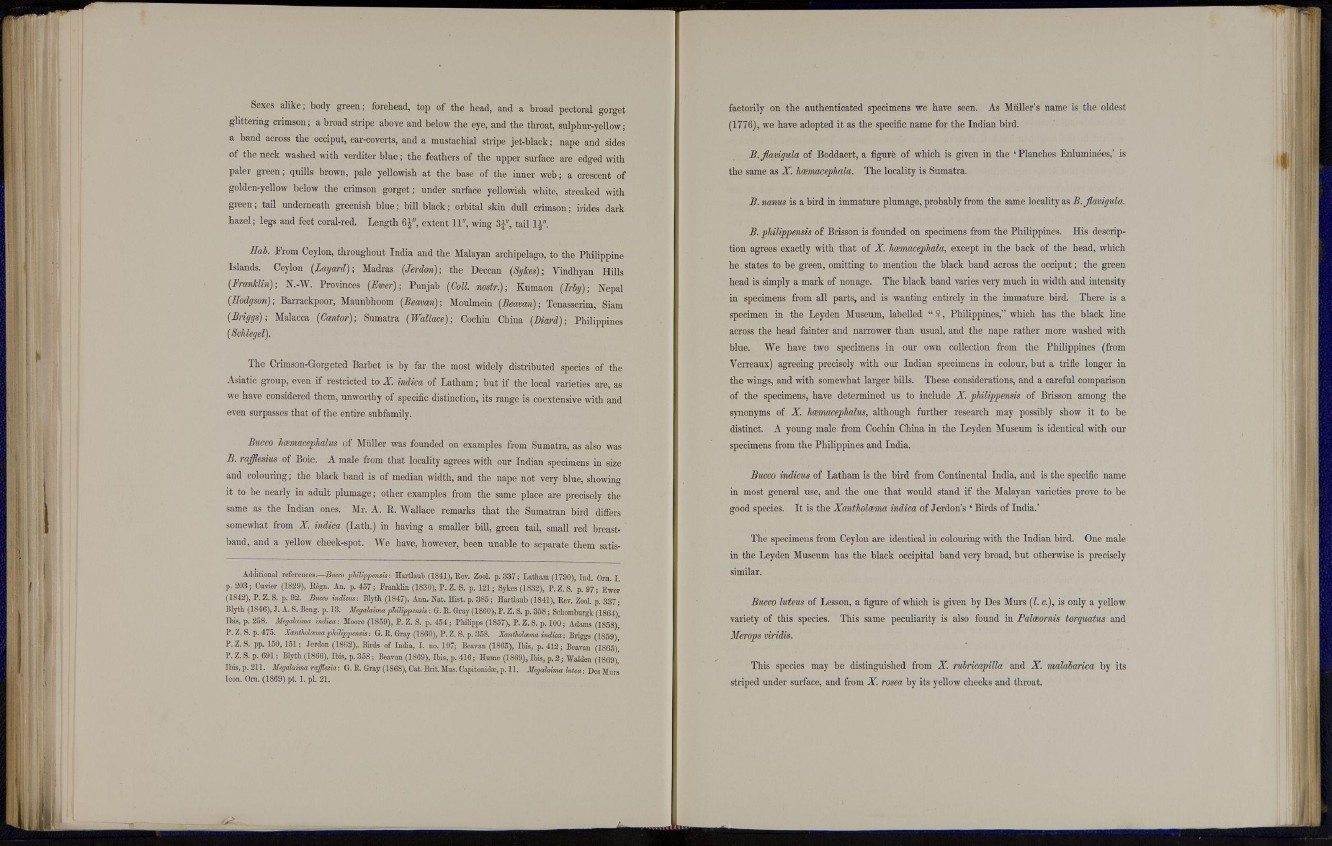
Sexes alike; body green; forehead, top of the head, and a broad pectoral gorget
glittering crimson; a broad stripe above and below the eye, and t h e throat, sulphur-yellow;
a band across the occiput, ear-coverts, and a mustachial stripe jet-black; nape and sides
of the neck washed with verditer b l u e ; the feathers of the upper surface are edged with
paler green; quills brown, pale yellowish at the base of the inner web; a crescent of
golden-yellow below the crimson gorget; under surface yellowish white, streaked with
green; tail underneath greenish blue; bill black; orbital skin dull crimson; hides dark
hazel; legs and feet coral-red. Length 6^", extent 11", wing 3.J", tail 1J".
Ilab. From Ceylon, throughout India and t h e Malayan archipelago, to the Philippine
Islands. Ceylon (Layard); Madras (Jerdon); the Deccan (Sykes); Vindhyan Hills
(Franklin); N.-W. Provinces (Ewer); Punjab (Coll. nostr.); Kumaon (Irby); Nepal
(Hodgson); Barrackpoor, Maunbhoom (Beavan); Moulmein (Beavan); Tenasserim, Siam
(Briggs); Malacca (Cantor); Sumatra (Wallace); Cochin China (Diard); Philippines
(Schlegel).
The Crimson-Gorgeted Barbet is by far the most widely distributed species of the
Asiatic group, even if restricted to X. indica of Latham; but if the local varieties are, as
we have considered them, unworthy of specific distinction, its range is coextensive with and
even surpasses that of the entire subfamily.
Bucco hamacephalus of Miillcr was founded on examples from Sumatra, as also was
B. rajfflesius of Boie. A male from that locality agrees with our Indian specimens in size
and colouring; the black band is of median width, and the nape not very blue, showing
it to be nearly in adult plumage; other examples from the same place are precisely the
same as the Indian ones. Mr. A. It. "Wallace remarks that the Sumatran bird differs
somewhat from X. indica (Lath.) in having a smaller bill, green tail, small red breastband,
and a yellow cheek-spot. We have, however, been unable to separate them satis-
Additional references.—Bucco pMUppensu: Hartlaub (1841), ltev. Zool. p. 337; Latham (1790), Ind. Orn. I.
p. 2 0 3 ; Cuvicr (1829), Regn. An. p. 4 5 7 ; Franklin (1830), P. Z. S. p. 121; Sykes (1832), P. Z. S. p. 9 7 ; Ewer
(1842), P.Z. S. p. 92. Bucco indieus: Blyth (1847), Ann. Nat. Hist. p. 3 8 5 ; Hartlaub (1841), Rov. Zool. p. 337;
Blyth (1846), J. A. S. Beng. p. 13. Megalaima philippensis: G. R. Gray (1860), P. Z. S. p. 358; Schomburgk (1804),
Ibis, p. 258. Megalaima indica: Moore (1859), P. Z. S. p. 454 ; Philippe (1857), P. Z. S. p. 100; Adams (1858),
P. Z. S. p. 475. Xanthotmna philippensis: G. R. Gray (1860), P. Z. S. p. 358. Xanthelasma indica: Briggs (1859),
P.Z.S. pp. 150, 151; Jerdon (1802),, Birds of India, I. no. 197; Beavan (1805), Ibis, p. 4 1 2 ; Beavan (1805),
P. Z. S. p. 6 9 1 ; Blyth (1866), Ibis, p. 358 ; Beavan (1869), Ibis, p. 416; Hume (1869), Ibis, p . 2 ; Waldcn (1809).
Ibis, p. 211. Megalaima rajjlesia : G. It. Gray (186S), Cat. Brit. Mus. G'apitonidrc, p. 11. Megalaima lutea: Dcs Mum
Icon. Orn. (1869) pt. 1. pi. 21.
factorily on the authenticated specimens we have seen. As Midler's name is t h e oldest
(1776), we have adopted it as t h e specific name for t h e Indian bird.
B.flavigula of Boddaert, a figure of which is given in t h e 'Planches Enluminées,' is
the same as X. hoemacephala. The locality is Sumatra.
B. nanus is a bird in immature plumage, probably from the same locality as B.flavigula.
B. philippensis of Brisson is founded on specimens from the Philippines. His description
agrees exactly with that of X. hoemacephala, except in the back of t he head, which
he states to be green, omitting to mention the black band across the occiput ; the green
head is simply a mark of nonage. The black band varies very much in width and intensity
in specimens from all parts, and is wanting entirely in the immature bird. There is a
specimen in the Leyden Museum, labelled " ? , Philippines," which has the black line
across the head fainter and narrower than usual, and t h e nape rather more washed with
blue. We have two specimens in our own collection from the Philippines (from
Verreaux) agreeing precisely with our Indian specimens in colour, but a trifle longer in
the wings, and with somewhat larger bills. These considerations, and a careful comparison
of the specimens, have determined us to include X. philippensis of Brisson among the
synonyms of X. hamacephalus, although further research may possibly show it to be
distinct. A young male from Cochin China in the Leyden Museum is identical with our
specimens from the Philippines and India.
Bucco indieus of Latham is the bird from Continental India, and is t h e specific name
in most general use, and t h e one that would stand if the Malayan varieties prove to be
good species. It is t h e Xantholoema indica of Jerdon's ' Birds of India.'
The specimens from Ceylon are identical in colouring with the Indian bird. One male
in the Leyden Museum has the black occipital band very broad, but otherwise is precisely
similar.
Bucco luteus of Lesson, a figure of which is given by Des Murs (I. c), is only a yellow
variety of this species. This same peculiarity is also found in Paloeornis torquatus and
Merops viridis.
This species may be distinguished from X. rubricapilla and X. malabarica by i ts
striped under surface, and from X. rosea by its yellow cheeks and throat.